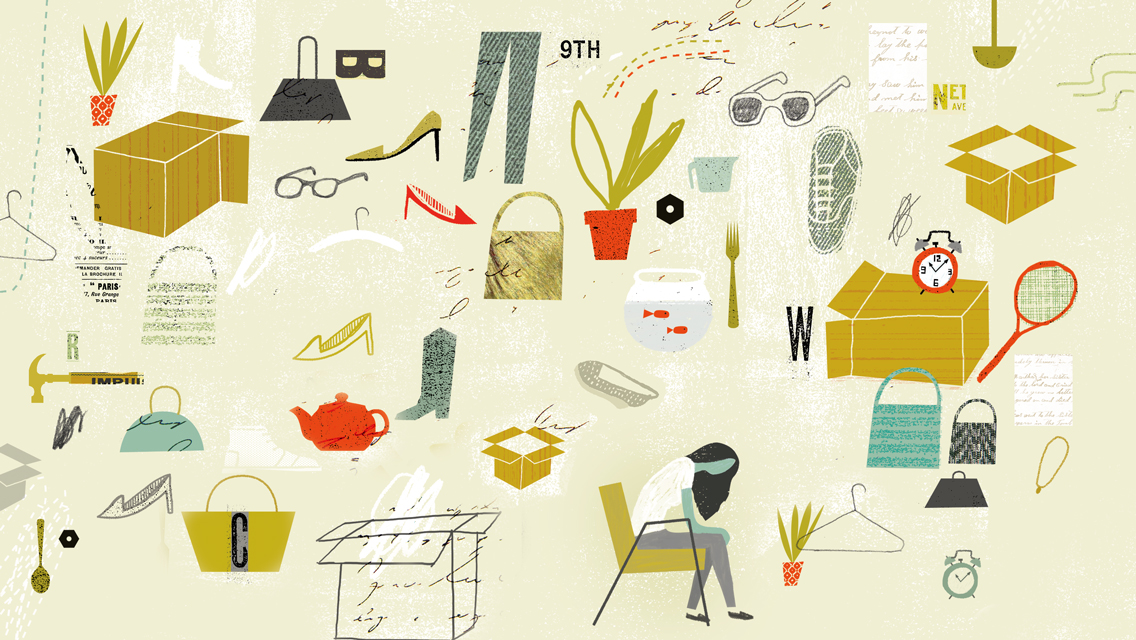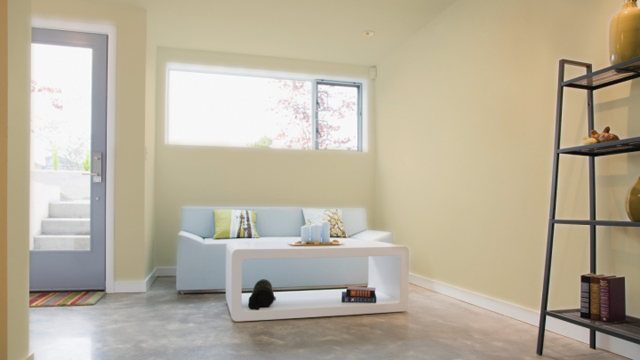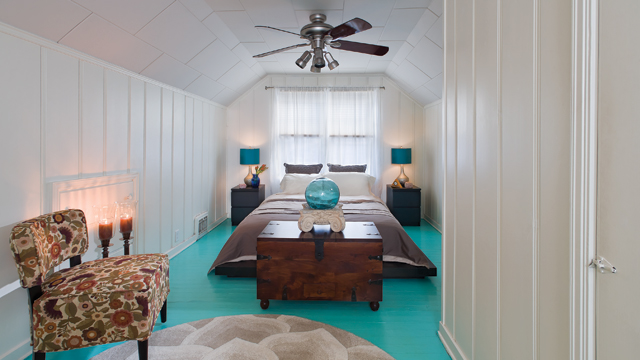Vida Ghaffari makes her living in the public eye. The hard-working actress has appeared in a number of TV shows and independent films, including 2012’s Cross My Heart, and also has made a name for herself as a television entertainment reporter. Until recently, though, the camera-friendly celebrity was hiding something behind the scenes. A lot of things, actually: Her Southern California home was packed full of tchotchkes, as well as clothes, accessories and shoes that she rarely wore.
Ghaffari had developed the habits of a collector as a child, when her mother showered her with gifts of Barbie dolls, and later, designer handbags, while insisting they not be taken out of the boxes. “Look-but-don’t-touch became a way of life,” she recalls.
This habit carried over into her adulthood and led to a home full of clutter, which took both a personal and professional toll. Ghaffari felt tired and overwhelmed, frequently showing up late to meetings and auditions because she couldn’t find the right outfit or makeup. “I was running around in constant I Love Lucy moments,” she says, “and not in a good way.”
Her closets were so packed with unworn clothes that Ghaffari couldn’t see what she owned or extract a shirt without struggle. One day in late 2010, as she was trying to put together an outfit for an important meeting, some extra garments she had placed on the top shelf fell out and hit her on the head. This was her liberating moment of clarity: Ghaffari made a New Year’s resolution to streamline her belongings.
She made it a daily practice to see what she could get rid of, eventually donating 20 bags of stuff to Goodwill. She also gave away lots of clothing and shoes to friends. As her home became less cluttered and more organized, both friends and colleagues began noting a corresponding transformation in Ghaffari.
“They sensed a difference,” she remembers. “They’d say to me, ‘Vida, you have a focus about you now. You’re not distracted. You’re on point.’”
Ghaffari did feel stronger and more confident, and it wasn’t long before she started booking more work: She was cast in a supporting role in the much-buzzed-about pilot for The Mindy Project, with a star of The Office, Mindy Kaling, which aired in September 2012. Producers and casting directors commented that she seemed to be more serious about her work.
While she wasn’t expecting all these benefits from her decluttering, Ghaffari was delighted with the psychological payoff. “I’m freer now,” she says, “and clearer, and more focused. I’m ready to do things in life, and I’m no longer held back.”
If you look at household clutter from a feng shui perspective, as author Tisha Morris does, Ghaffari’s story makes perfect sense. Morris, who penned Feng Shui Your Life: The Quick Guide to Decluttering Your Home and Renewing Your Life, asserts that our homes mirror our emotional state.
“Clutter is just stagnant energy,” she says. “Where there’s clutter in your home, there will be clutter in you — either physically, mentally or emotionally.”
“Clutter is just stagnant energy. Where there’s clutter in your home, there will be clutter in you — either physically, mentally or emotionally.”
Professional organizers, who are hired to help with everything from decluttering closets to restructuring entire homes, routinely see their clients reap emotional rewards. “It’s hard for me to even imagine talking about clutter without talking about the emotional benefits of decluttering,” says Hazel Thornton, professional organizer and owner of Organized for Life, a consulting service in Albuquerque, N.M. “There’s no one who calls me who isn’t stressed out, frustrated, or feeling inadequate, incompetent in their job, or guilty. It’s all about emotions — definitely it’s more about emotions than it is about the stuff.”
In many cases, the way clutter affects us has little to do with quantity. A piece of art painted by an ex-lover hanging over the bed can carry more emotional heft than a messy closetful of extra sheets and towels. A chaotic corner of art supplies can feel like an inspiring springboard — and a year later, if the supplies haven’t been touched, like a landscape of failure.
In other words, identifying an item as clutter has more to do with how it feels than how it looks. If you feel less than great in certain rooms or even your entire house, it might be time to target a few items (or a few dozen) for removal.
Here you’ll find a guide to the most common kinds of clutter, the emotional signals they may be broadcasting, and the toll they could be taking on your life. Start seeing your questionable stuff in this clear new light, and you may start feeling a whole lot more ready to let it go.
Other People’s Stuff
Whether it’s belongings stored for a friend in a garage or basement, or the stuff your kids left behind when they moved out, storing other people’s things can be a signal that you need to be more assertive about your space. “When [other people’s stuff] gets to be a problem, that’s all about setting appropriate boundaries,” Morris explains. “Our home is a template for our own energy, so when people store things in your home, those people are taking up your energy.”
If you do decide to let people leave their belongings with you, Morris recommends being very specific about how long you’re willing to turn your home into a storage locker. “Say, ‘OK, I’ll store this for six months and after that you need to come get it.’ [You] can still make the decision to do it, but at least [you’re] conscious of it.”
The belongings of deceased loved ones also fall into this category. After the initial shock of losing someone, it may not feel right to dispense with all of his or her things. But hanging on to an entire collection of china or oversized suits you don’t really want and can’t use — especially if they’re packed away in boxes somewhere out of sight — doesn’t honor a loved one’s memory as effectively as choosing a few special items to actively enjoy or display.
In Thornton’s experience, this particular kind of letting go is “a huge emotional issue.” She describes working with a client whose husband had died nine years earlier. The client had several remaining boxes of her husband’s things she referred to as “the hard stuff”: personal items and career souvenirs that she didn’t really want but couldn’t bear to donate or throw away. Together they figured out a plan to turn the boxes into a source of comfort rather than pain.
“She really revitalized her whole life by reducing clutter. She’s so active now — she goes hiking and she skis; she has the energy and feels free to go do these things she wasn’t doing before.”
“Her husband had kids from a previous marriage, and we made a box for each of them. Sometimes it’s just a matter of finding a good home for something,” Thornton remembers. “We were able to divide up some of the things, and she kept a few cherished items, and that’s how we resolved it. She made a point to get comfortable with how she cleared the clutter and where she could go from there.”
Thornton’s client soon felt motivated to go into a room she had left untouched since her husband’s death: his workshop. “It was a mess,” Thornton recalls, “but we organized it to the point where it was beautiful and functional. Now we’re adding color to her life, painting accent walls and putting up pictures.
“She really revitalized her whole life by reducing clutter. She’s so active now — she goes hiking and she skis; she has the energy and feels free to go do these things she wasn’t doing before.”
Out of the Past
Having a sense of history in a home is one thing, making it a temple of nostalgia is another. Whether you’re holding on to stacks of high school yearbooks or jeans from college that no longer fit, releasing unhelpful reminders of the past can free you up to move forward.
“When all your available space is filled with clutter, there is no room for anything new to come into your life,” writes Karen Kingston, author of Clear Your Clutter with Feng Shui. “Your thoughts tend to dwell in the past, and you feel bogged down with problems that have dogged you for some time. You tend to look back rather than forward in your life, blaming the past for your current situation rather than taking responsibility for creating a better tomorrow.”
DeAnna Radaj, an “eco-shui” home designer based in Charlotte, N.C., encourages clients to let go of items that look nice but are holding them back emotionally. “A friend had a beautiful cashmere sweater that had been a gift from her ex-husband,” she says. “Every time she’d get a compliment on it and someone would ask where she got it, all these uncomfortable emotions would rise to the surface, and she would relive everything negative about the relationship.”
“You have to ask yourself: Is it really that you have feelings for the person on some level and can’t let the relationship go?”
Radaj’s friend didn’t want to part with the sweater, saying it was beautiful and expensive. But Radaj believes that expense alone is not a good reason to keep something that’s causing you annoyance or discomfort. “You have to ask yourself: Is it really that you have feelings for the person on some level and can’t let the relationship go?”
Releasing emotionally charged objects can take soul-searching work, tears and sometimes even flames, says professional organizer Melinda Massie, who occasionally advises clients to ritually burn objects they need to part with permanently. “If it’s physically possible,” she says, “I like to set that stuff on fire — with the proper precautions, of course.”
She acknowledges that the process of ditching nostalgic stuff can be profoundly challenging. “Be compassionate with yourself,” she advises. “When you come to something that’s [painful], sit with it. Don’t judge it or get mad at yourself about it.”
You don’t have to burn down the house you shared with your ex to create a sense of closure, she notes. Repaint. Get new sheets for the bed. Or, if you must light a match, burn some candles, sage or incense to reclaim the space as your own.
Unused Goods
Plenty of pantries contain stacks of unused appliances and unchristened cake pans. Home offices are stocked with boxes of file folders, paper clips and reams of paper that have no hope of ever getting used. And it’s a good guess that the number of shiny, untouched tools that fill garages could stretch around the equator — twice.
According to Kingston, piles of unused stuff can signal “just in case” thinking, which “indicates a lack of trust in the future.” This can create a bigger cycle of distrust, she explains. “If you have lots of clutter you are hanging on to because you think this way, you are sending out a frequency of not trusting, and you will always feel vulnerable and insecure about the future.”
Unused items can also represent an unmet aspiration, says Geralin Thomas, a professional organizer who appears often on the A&E network’s show Hoarders: “Often, people’s clutter is tied up with their identity. Who are you? ‘Well, look in my pantry: I have a KitchenAid mixer and 64 copper cookie molds and a cookie press.’ But then when you talk further, you may find out that the person has never made cookies.”
“Your house should be a respite from the world. A place where you want to enjoy your life, a place where you can enjoy your family, your friends, your spiritual practice.”
While there’s nothing wrong with having aspirations, Thomas explains, she also feels that “your house has to be something other than just a container for your stuff. You need to figure out if your possessions orient you toward having or being. The ‘havings’ want to acquire and possess. For ‘beings,’ it’s all about experience. The beings are eager to let go of things that aren’t being enjoyed and used; the opposite is true for the havings.
“Your house should be a respite from the world. A place where you want to enjoy your life, a place where you can enjoy your family, your friends, your spiritual practice, whatever you’re into. But if you’re not into the stuff that’s in your house, then it’s got to go. It doesn’t tell the story of who you are.”
Giving away unused belongings, especially those in good condition, not only benefits others, it can help you rewrite the story of who you are. Being comfortable with a little empty space helps make room for new things, experiences and even friendships.
“Clutter — and all the shame that comes along with it — tends to isolate,” says Pesi Dinnerstein, author of A Cluttered Life: Searching for God, Serenity, and My Missing Keys. “Who wants to invite someone in to see the mess that we ourselves don’t want to admit is there? But I’ve found that allowing myself to be vulnerable and ask for help has not only made the decluttering process more successful, it has also deepened my connection to the people I care about.”
Incomplete Projects
Having projects in process around the house is common and, in some cases, necessary. (After all, a project, by its very definition, is a work in progress.) Still, when half-knitted sweaters or stalled kitchen remodels sit too long, they start to broadcast troubling messages. Unfinished projects are often accompanied by a sense of failure, says Morris. “A lot of times, that stems from perfectionism — it will never be good enough, not perfect enough, so they just won’t finish it.”
Morris believes it’s important to acknowledge when you’re not finishing a project in a reasonable amount of time. If something sits untouched for six months with no major life events distracting you, it’s time for review. If you realize you’re really not going to finish something, Morris recommends unloading materials at a donation site. Many charities are eager to pick up unused paint and scrap wood from aborted building projects, and Etsy.com is full of crafters happy to take half-finished quilts and other sewing projects off your hands. Getting rid of that material will be helpful, Morris says, “because the subconscious mind knows those unfinished projects are sitting in a drawer or a closet — and it’s a constant reminder of failure.”
[The] subconscious mind knows those unfinished projects are sitting in a drawer or a closet — and it’s a constant reminder of failure.”
Massie suggests creating a list of each and every one of your unfinished projects. Since some projects need to be completed before others can start, prioritize them. Then, she says, “go through the list and see what is worth your time. Is the outcome going to be worth the energy you put into it? If so, fabulous! Give it a deadline and make it happen. If you don’t finish in that time, give it away and let it go, guilt free.”
Once you’ve cleared out looming unfinished projects, she says, you can focus on the ones you care about most in the present. The rewards of that will be ongoing, as will the rewards of getting rid of any other stuff that weighs you down.
The freedom that comes with a clear space is tinged with possibility for new experiences — and isn’t that more enticing than that box of old, mismatched socks?
What Is Your Stuff Saying to You?
Different kinds of clutter signify different emotional messages. Here are a few of the most common.
Piles of Other People’s Stuff
You may have trouble setting boundaries, saying no and protecting your own energy reserves. Set time limits for storing other people’s belongings, if you’re going to store them at all, and be firm. (See “How to Set Clear Boundaries” if this sounds familiar.)
Excessive Reminders of the Past
You might have a tendency to blame the past for your current situation, or to think your best days are behind you. Try letting go of any object — however lovely or sentimental — if looking at it disturbs you or brings you down.
Rarely Used or Never-Been-Used Items
Stacks of unopened or unused items can signal “just in case” thinking, and a lack of trust in the future. They can also signal an aspiration to do or be something you’re not. Make a realistic assessment, then either use or dispense with whatever your “wish self” is hanging on to.
Unfinished Projects
Half-completed paintings and half-finished remodels can suggest an unsustainable perfectionism, and may provoke a sense of failure. Take stock of all the projects you currently have “in process.” Then be willing to let go, clean up and move on.




This Post Has 0 Comments